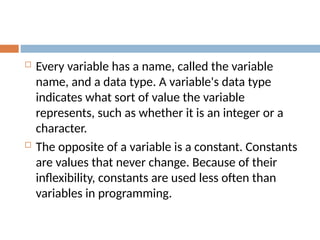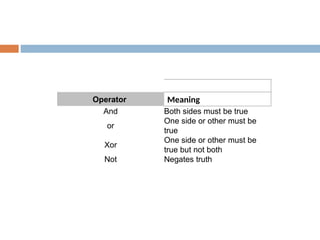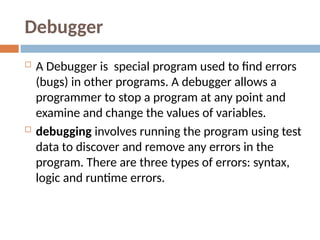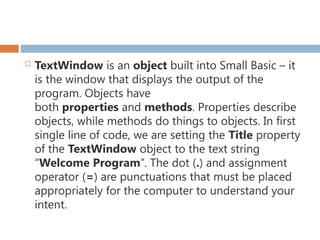Ad
Introduction to high level Computer programming
- 2. Computer programming Computer Programming is defined as the process of creating computer software using a programming Language. Computer programs are written by Human individuals(Programmers) A computer program is a step by step set of instructions that a computer has to work through in a logical sequence in order to carry out a particular task. The computer executes these instructions (obeys the instructions) when told to do so by the user.
- 3. Programming Languages Programming languages are the vocabulary and set of grammatical rules for instructing a computer to perform specific tasks. There are many different types of programming languages each having a unique set of keywords (words that it understands) and a special syntax (grammar)for organising program instructions.
- 4. Syntax Syntax refers to the spelling and grammar of a programming language. Each program defines its own syntactical rules that control which words the computer understands, which combinations of words are meaningful, and what punctuation is necessary. Text-based programming languages are based on sequences of characters, while visual programming languages are based on the spatial layout and connections between symbols (which may be textual or graphical).
- 5. Example of a program code (small basic) TextWindow.Writeline("enter the Temperature in fahrenheit ") fahr = TextWindow.ReadNumber() celsius = (5 * (fahr - 32) / 9) TextWindow.WriteLine("This Temperature in celcius is " + celsius +" degrees")
- 6. Small Basic TextWindow.Write("Enter the temperature today (in F):") temp = TextWindow.ReadNumber() If temp > 100 Then TextWindow.WriteLine("It is pretty hot.") ElseIf temp > 70 Then TextWindow.WriteLine("It is pretty nice.") ElseIf temp > 50 Then TextWindow.WriteLine("Don't forget your coat.") Else TextWindow.WriteLine("Stay home.") EndIf
- 7. There are many computer programming languages and so the programmer will have to decide which one to use for solving a particular problem. These languages must be learnt just as Swahili, English or French etc.
- 8. Levels of programming languages Programming languages are classified into five major categories: machine languages (first generation languages), assembly languages (second generation languages), third generation languages, fourth generation languages, and natural languages. Machine and assembly languages are referred to as low level languages; third generation, fourth generation and natural languages are categorised as high level languages.
- 9. A low level language is machine dependent; that is, it is written to run on one particular computer. A high level language is machine independent, which means the high level language code can run on many different types of computer. There are two types of low-level programming languages: Machine Language and Assembly Language.
- 10. Machine language – First Generation Language (1GL) The machine language writes programs using the machine code of 1s and 0s, which is directly understood by the computer. The main problems with using machine code directly are that it is very easy to make a mistake, and very hard to find it once you realise the mistake has been made.
- 11. Characteristics of 1GL Fastest to execute because it is already in the language that the computer can understand Difficult to interpret (requires the aid of a reference manual to interpret the meaning of each code) Easy to make mistakes in the sequence of 1s and 0s; replacing a 1 for a 0 can result in the wrong command/instruction being executed It is difficult to identify mistakes made Time-consuming and tedious to write Machine dependent Programing becomes more difficult as the complexity of the program increases
- 12. Assembly language – Second Generation Language (2GL) Assembly language is written using mnemonic codes (abbreviated English words) or short codes that suggest their meaning and are therefore easier to remember. These codes represent operations, addresses that relate to main memory, and storage registers of the computer. Typical codes might be: LDA, STO, ADD, NOP, etc.
- 13. An example of a program code to add and store two numbers would be: LDA A, 20 : load accumulator A with the value 20 ADD A, 10 : add the value 10 to accumulator A STO B, A : store contents of accumulator A into storage register B NOP: no operation (stop here)
- 14. Characteristics of 2GL As with machine language, assembly language is machine dependent. Assembly language, being machine dependent, is faster and more efficient in the use of hardware than high-level programming languages. Assembly languages have to be translated into machine language by language translators known as assemblers for the processor to understand. Easier to write than machine language The code is not very easy to understand, hence the introduction of high level programming languages.
- 15. High-level programming languages High level programming language is defined as one that is machine independent and uses variables and objects, Boolean expressions, functions, loops, arrays, threads, locks which are similar to their meaning (abstraction). High-level languages have evolved over the years and can be grouped into five categories: Third Generation Languages (3GL), Fourth Generation Languages (4GL), Object Oriented Programming Languages (OOP), Fifth Generation Languages (5GL) and Scripting Languages
- 16. These languages are problem oriented, so they are machine independent. Since high-level languages reflect the logic and procedures used in a human algorithm, the programmer is able to concentrate on developing task algorithms rather than on how the computer will carry out the instructions. the programmer must still specify a complete set of detailed instructions. The words and grammar of high- level languages are English-like and this makes the programs more readable and easy to write.
- 17. high-level languages are machine independent (they can be used on different computer systems); Since the syntaxes of high-level languages are standardised, the languages are portable. A high-level language is governed by a strict syntax (set of grammatical rules). they are easier to read, write, and maintain. They also permit faster development of large programs. programs written in a high-level language must be translated into machine language by a compiler or interpreter.
- 18. Characteristics of high-level languages They are machine independent hence portable They are user friendly and easy to learn High-level language programs are easy to debug They are more flexible hence they enhance the creativity of the programmer, increasing productivity They are executed much slower than low-level programming languages They have to be translated into machine code before execution, this is done by compilers and Assemblers. One instruction translates into several machine code instructions
- 19. Assemblers and Compilers Assemblers and Compilers are programs that convert high level languages into machine code. A Compiler is a program that converts the entire source code(compiles it) into machine language at one time before the computer can run the program at a later time. While compiling the source code into machine code, it checks that the syntax is properly written by the programmer for the programmer to debug the program.
- 20. The interpreters are programs that translates the high level program code one statement at a time, that is, it reads a code statement, converts it to one or more machine language instructions, and then executes the instruction before moving translating the next code statement in the program. If there is any error in the statement, the programmer can correct the error before the interpreter evaluates the next statement. Interpreters are slower than Compilers because interpreters convert a statement at a time and runs it before moving to the next line.
- 21. Object-Oriented programming (OOP) Object-oriented programming (OOP) is a programming language model organized around objects and data. In OOP, the programmer packages the data and the program procedures into a single unit called an object. The procedures in the object are called Operations(Methods or behavior), and the data elements are called attributes(Variables); this means that a part from looking at the data structure, the methods associated with that object used to modify the object’s attributed must be considered.
- 22. A method is an operation or function which can modify an object’s behavior i.e. that changes an object by manipulating its variables, a function is a sequence of commands or programming code that returns a value (sends a result back). Think of it as "What method would you use to add two numbers together?"
- 23. The concept of packaging methods and attributes into a single object is what is known as encapsulation(information hiding) And Object may be part of a larger category of objects called a Class; every object in a class share the similar methods and attributes as the original object. Each class can have one or more lower levels called sub-classes, the higher level class is called a super class. Each subclass inherits the methods and attributes of the objects in its super-class. This concept of the lower levels inheriting methods and attributes of higher levels is called inheritance.
- 24. Illustration of relationships between classes and objects
- 25. Major high level programming languages used FORTRAN (FOTmula TRAnslator)developed in the late 1950s developed to design scientific applications COBOL (Common Business Oriented Language) developed in early 1960s to develop business applications. RPG (Report Program generator) was developed in early 1960s to assist in generating reports and complex calculations.
- 26. BASIC (Beginner’s All-purpose symbolic instruction code) developed in mid 1960 Basic versions include MS-BASIC, QBASIC, SmallBASIC and visual basic. Pascal was developed in the late 1960s for the purpose of teaching structured programming concepts C developed in the early 1970s to write system software Ada was developed in the late 1970s originally developed to meet the needs of embedded computer systems
- 27. C++ developed in the 1980s is an object-oriented language mainly to develop application software Note that in addition to the major languages discussed above, there are many other programming languages that have been developed such as JavaScript, and Python
- 28. Language Translators Language translators are system programs that convert assembly language and high-level language into the machine language. The computer does not understand assembly languages or high-level languages. Computers work in machine code or machine language.
- 29. Source code Source code is a program code of either an assembly language or high-level language that the programmers write in a program editor. Source code cannot be understood by the computer until it has been translated into machine code.
- 30. Object code Object code is a program code in machine- readable form (a source program that has been translated).
- 31. Assemblers The assembly-language program must be translated into machine code by a separate program called an assembler. The assembler program recognises the character strings that make up the symbolic names of the various machine operations, and substitutes the required machine code for each instruction.
- 32. Compilers Compilers are language translators that translate high-level languages into machine code. A compiler translates the entire program (source code) to machine code, and then the code is executed. The translated codes are known as object codes and are saved as a file on disk. The object code (machine code) stored on disk has an EXE file name extension. It is then loaded or linked (stored in memory) and executed
- 33. How a Compiler works
- 34. Interpreters Interpreters are language translators that translate high-level language into machine code. An interpreter translates and executes one instruction at a time as it is encountered. The machine codes are not saved after execution
- 35. How an Interpreter works
- 36. The program development life cycle (PDLC) During the development of a program there are several stages. These can be described by the Program Development Life Cycle (PDLS)which has several steps which lead to the solution of the problem.
- 37. PDLC is the continuous process that consists of five/six general steps: 1. Analyse problem 2. Design program 3. Code program 4. Test program 5. Formalise program 6. Maintain program
- 38. PDLC
- 39. Problem analysis This involves problem recognition, which involves identifying the need to overcome a given problem for example, the need for a school to process students marks and grade accurately at the end of term and problem definition, which involves identifying the users program objectives, desired inputs, outputs, and processing.
- 40. Defining the problem In defining the problem there must be no ambiguity. The problem should be clear and concise and have only one meaning. Examples of unambiguous problems are: i) Calculating the price of an item after a 10% discount ii) Converting a temperature from ° C to ° F iii) Computing the average rainfall for the month of May in a certain place.
- 41. Analysing the problem In order to develop an algorithm to accomplish a certain task you must analyse the task as a sequence of instructions that can be performed by the computer. These instructions can be divided into three main parts: input and storage instructions, processing instructions, and output instructions.
- 42. Input and storage instructions These instructions allow information or data to be accepted by the computer. The input is information that is needed by the computer to solve the problem. Words such as ‘Enter’, ‘Input’ and ‘Read’ within problem statements usually indicate what data the computer requires.
- 43. What are the input and storage instructions here? Read the price of an item and calculate the discount of 10%. Enter the name and year of birth of a person and calculate the person’s age. Input the length of a side of a square tile and find the area.
- 44. Let’s analyse these instructions to determine the inputs and what we need to store: Read and store the price of an item. Enter the name and year of birth of a person. Input the length of the side of a square tile.
- 45. Processing instructions These instructions manipulate the input data. They involve calculations, that is, mathematical operations (e.g. addition, subtraction, multiplication and division), repeating instructions, selecting instructions and comparison instructions. They also include commands and constructs.
- 46. A command is a word that instructs the computer what must be done to accomplish a specific task. Commands are specific to a particular programming language: for example, WRITE, PRINT, READ, INPUT, etc. A construct is a group of instructions that work together with commands to accomplish a specific task. An example is the ‘IF-THEN’ construct:
- 47. Example of a construct IF a < 10 THEN READ Num ENDIF
- 48. What are the processing instructions here? Read the price of an item and calculate the new price after a 10% discount. Enter a temperature in degrees Celsius and convert it to degrees Fahrenheit. Input the name and year of birth and compute and print the age of a person.
- 49. Let’s analyse these instructions to determine what we need to process. Calculate the new price after a 10% discount. Convert it to degrees Fahrenheit. Compute the age of a person.
- 50. Repeating and comparison statements Comparison/selection/decision statements involve determining whether a condition is true or false in order to perform a set of instructions. For example: Read the weekly hours worked by an employee. If the hours worked are greater than 40, then calculate the overtime salary at 1.5 times the standard hourly rate of $1.75, for those hours over 40. The condition that is checked is the number of hours worked to determine if it is more than 40.
- 51. Repeat statements/loops/iterations are used when a problem has to be done a number of times. For example: Read the marks for three subjects, English, Maths and ICT for each student; find the average mark of each student in a class of 15, over the three subjects. The process of finding the average for the three subjects has to be repeated 15 times.
- 52. Output instructions These instructions allow information to be displayed on the screen. Problem statements that include key words like ‘print’, ‘output’, ‘display’, ‘return’ and ‘write’ indicate what data should be output to the screen. What are the output statements here? Enter the name and year of birth of a person and compute and display the age of the person. Write an algorithm to print a conversion table of degrees Celsius to degrees Fahrenheit, 10 C to 20 C inclusive.
- 53. Let’s analyse these instructions to determine what we need to output. Display the age of the person. Print a conversion table.
- 54. Program design This is the actual development of a program’s processing logic. The program’s processing logic is called its algorithm. An algorithm is a sequence of instructions which, if followed, produces a solution to the given problem. At the end of each instruction, there is no question as to what needs to be done next, and the instructions eventually come to an end. An algorithm is written using special rules and statements
- 55. Example of an algorithm Algorithm: Read student name and marks obtained. Calculate total marks and average marks. Write student name, total marks, average marks.
- 56. Program design involves three tasks: (i) grouping the program activity into modules (ii) develop a solution algorithm for each module. An algorithms are well defined rules for solving a problem (iii) test the solution algorithm
- 57. The first task that involves grouping tasks into modules focuses on what must be done (requirements) where the Top-bottom design is used. This involves breaking down the program into smaller, manageable components represented graphically on a hierarchy chart; the top most showing the main module referred as the main routine, which is then subdivided into smaller sections also referred to as sub-routines. Each module is represented by a rectangle labeled by its name.
- 58. Drop-down chart
- 59. Design details using Pseudo-code, flowcharts and control structures Once the essential logic of the program has been determined through the use of top-down programming and hierarchy charts, you can now work on the details. The two ways to show program details are writing the details using pseudocode or drawing the details using flowcharts, or both.
- 60. Pseudo-code A Pseudo-code is an algorithm that models or resembles the real programming language of the computer. A Pseudo-code can also be defined as a tool for designing a program in a narrative form using human language statements to describe the logic and processing flow.
- 61. Pseudocode START READ student name, mark1, mark2, mark3, mark4 Totalmarks = mark1 + mark2 + mark3 + mark4 Averagemark = Totalmarks / 4 PRINT student name, totalmarks, averagemarks STOP
- 62. Pseudo-code commonly used keywords Several keywords are often used to indicate common input, output, and processing operations. Input: READ, OBTAIN, GET Output: PRINT, DISPLAY, SHOW, writeline Compute: COMPUTE, CALCULATE, DETERMINE Initialize: SET, INIT Add one: INCREMENT, BUMP
- 63. Program flow chart A program flowchart is a diagrammatic representation of a program’s processing logic. It uses standard symbols called ANSI symbols (called after the American National Standards Institute that developed them) and short statements that describe various activities. A flowchart shows how your program works before you begin actually coding it.
- 65. AN EXAMPLE OF A FLOW CHART Begin ENTER TWO NUMBERS;A,B CALCULATE SUM=A+B AVERAGE = SUM/2 AVERAGE >=60? GRADE =“A” PRINT SUM,AVERAGE AND GRADE END GRADE = “B”
- 67. Lamp flowchart
- 68. Structured program designs When designing a program, you must reason through the problem to determine the correct logic. The logic of a program can be established through the use of control structures. Structure design involves identifying the logical order of the procedure required to accomplish the task described in a given module. This procedure is what is known as the solution algorithm or program logic. Control structures or logic structures/constructs control the logic sequence in which computer program instructions are executed.
- 69. Four basic control structures are used to form the logic of a program in structured program design: sequence, selection, case and iteration (loop).
- 70. The Sequence control structure The sequence structure is used to show a single action or one action followed sequentially by another e.g. reading a record, followed by calculating totals and averages and then printing the averages.
- 72. The Selection control structure (if- then-else) Selection is a process that allows a computer program to compare values and then decide what course of action to take based on a certain condition. The selection structure therefore is used to tell the program which action to take next, based on a certain condition; when the condition is evaluated, its result is either true or false : if the result of the condition is true, then one action is performed; if the result of the condition is false, a different or no action is performed.
- 73. For example, a condition that if the average mark is 50 and above, the student is passed, or else, the student fails. i.e. if a condition is true, then do one thing, else do another. Because of the above, the selection structure is also known as the if-then-else control structure.
- 74. IF score >= 60 THEN Comment = "Pass" ELSE Comment = "Fail" ENDIF PRINT comment
- 75. Selection control structure flowchart Test condition THEN statement ELSE statement No Yes
- 76. If ..then.. else If(age <30)Then TextWindow.WriteLine("too young ") Else TextWindow.WriteLine(“too old ") endif
- 77. If (Clock.Hour < 12) Then TextWindow.WriteLine("Good Morning World") EndIf If (Clock.Hour >= 12) Then TextWindow.WriteLine("Good Evening World") EndIf
- 78. Case control structure The case control structure is a variation of the selection structure that involves more than a single yes-or-no decision. The case structure allows several alternatives or cases to be presented. The case control structure saves the programmer the trouble of having to indicate a lot of separate IF… THEN…ELSE conditions.
- 79. Example of an IF…THEN…ELSE structure involving several alternatives: IF score <= 100 AND score >= 80 THEN grade = "A" ELSE IF score >= 75 AND score <= 79 THEN grade="A-" ELSE IF score >= 70 AND score <= 74 THEN grade = "B+" ELSE IF score >= 65 AND score <= 69 THEN grade = "B" ELSE IF score >= 60 AND score <= 64 THEN grade = "B-" ELSE IF score >= 55 AND score <= 59 THEN grade = "C+"” ELSE IF score >= 50 AND score <= 54 THEN grade = "C" ELSE grade="F" ENDIF PRINT grade
- 80. Example of case structure involving several alternatives CASE score OF 80 – 100: grade = "A" 75 - 79: grade ="A-" 70- 74: grade = "B+" 65 - 69: grade = "B" 60 - 64: grade = "B"” 55- 59: grade = "C+" 50- 54: grade = "C" 0-49: grade="F" END CASE PRINT grade
- 81. The other possible selection control structure is known as a case control structure which is used where a condition can yield one of more than two possibilities. Using the If....Then....ElseIf statement.
- 82. If....Then...ElseIf Statement If there are more than two alternative choices, using just If....Then....Else statement will not be enough. In order to provide more choices, we can use the If....Then...ElseIf Statement. The general format for the if...then.. Else statement is If (condition) Then expression ElseIf condition Then expression ElseIf condition Then expression Else expression End If
- 83. When executing a block If (second syntax), condition is tested. If condition is True, the statements following Then are executed. If condition is False, each ElseIf (if any) is evaluated in turn. When a True condition is found, the statements following the associated Then are executed. If none of the ElseIf statements are True (or there are noElseIf clauses), the statements following Else are executed. After executing the statements following Then or Else, execution continues with the statement following End If.
- 84. The Repetition control structure (Iteration) The repetition control structure is also known as the looping, or iteration control structure. It is used when a set of actions are to be performed repeatedly as long as a certain condition is met. Iteration or looping is where a process(routine) is done repeatedly. There are two forms iteration; the Conditional and the unconditional looping.
- 85. Conditional looping A conditional looping is one that is repeated until a specified condition is met. It uses a selection process to decide whether or not to carry on a process. Conditional looping are of two forms; Do-while and do-until
- 86. The do-while repetition control structure This control repeats as long as a condition is true, it tests the condition at the beginning of the loop and, if the result of the condition is true, the action(s) inside the loop is executed. Then the program loops back and tests the condition again, if the result is still true, the action(s) inside the loop is executed again. This continues until the condition becomes false.
- 87. The Do -While loop In the program below, we assign the value 100 to number and run the while loop as long as number is greater than 1. Inside the loop, we print out the number and then we divide it by two, effectively halving it. And as expected, the output of the program is numbers that are progressively getting halved one after another.
- 88. number = 100 While (number > 1) TextWindow.WriteLine(number) number = number / 2 EndWhile
- 89. The do-until selection control structure This is similar to the do-while control but has two major differences, first the do-until control structure tests the condition at the end of the loop. Secondly the structure exits the loop when the condition is true, i.e. until a condition is met.
- 90. Unconditional looping (For loop) Unconditional looping are those that carry out a process a set number of times before it ends. For example the following code will print out numbers from 1 to 24 before it stops; For i = 1 To 24 TextWindow.WriteLine(i) EndFor
- 91. Coding the program Program coding is the actual writing of the program to get a program source code using a specific programming language once the design has been developed and reviewed. Computer programs are written using the specific rules and statements of the particular computer language being used, much like grammar rules in the English language. The specific rule for writing instructions in a particular computer language is known as syntax. The programmer therefore must follow the syntax of the language being used.
- 92. Arrays This object provides a way of storing more than one value for a given name. These values can be accessed by another index (key). For example, the program can store the names of individuals in class plus their marks, address and age which can be selected by the index. For example, in the code below, data on individuals of their name, age, and address is accessed using “person” as the index
- 93. person["Name "] = " Kizito Samuel" person["Age "] = 30 person["Address "] = " Wakiso" TextWindow.WriteLine(person)
- 94. Variables A variable is defined as a place in computer memory where you can store values temporarily and use them later, represented as a symbol or name associated with a value and whose associated value may be changed. Variables can represent numeric values, characters, character strings, or memory addresses. Rather than entering data directly into a program, a programmer can use variables to represent the data. Then, when the program is executed, the variables are replaced with real data. This makes it possible for the same program to process different sets of data.
- 95. Every variable has a name, called the variable name, and a data type. A variable's data type indicates what sort of value the variable represents, such as whether it is an integer or a character. The opposite of a variable is a constant. Constants are values that never change. Because of their inflexibility, constants are used less often than variables in programming.
- 96. Using variables: example (small Basic) number1 = 10 number2 = 20 number3 = number1 * number2 TextWindow.WriteLine(number3)
- 97. TextWindow.Write("Enter temperature in Fahrenheit: ") fahr = TextWindow.ReadNumber() Celsius = 5 * (fahr - 32) / 9 TextWindow.WriteLine("Temperature in Celsius is " + Celsius)
- 98. Data types used in a programming language Programming languages use three main types of data: numeric, string (or text) and Boolean variables. Numeric variables can store integer or decimal numbers. They can be positive or negative. A string variable is one that stores a string (list) of various characters. A string can be a name, a string of numbers, a sentence, a paragraph, any characters at all. And, many times, a string will contain no characters at all i.e. (). Strings are always enclosed in quotes (“). Examples of strings: (“I “ am a Small Basic programmer”) (“012345”), (“Title Author”)
- 99. Control of program flow Program flow is controlled by using both Conditional operators and Logical operators
- 100. Conditional operators Conditional operators are also known as numerical comparison operators. Normally they are used to compare two values to see whether they are equal or one value is greater or less than the other value, then the program decides what actions to take, e.g. whether to execute a program or terminate the program.
- 101. Conditional Operators Operator Meaning = Equal to > More than < Less Than >= More than and equal <= Less than and equal <> Not Equal to
- 102. Logical operators These are operators that allow a program to make a decision based on multiple conditions. Each operand is considered a condition that can be evaluated to be a true or false value. Then the value of the conditions is used to determine the overall value of the op1 operator op2 or !op1 or both.
- 103. Operator Meaning And Both sides must be true or One side or other must be true Xor One side or other must be true but not both Not Negates truth
- 104. Program testing and debugging This involves going through the program to identify and correct errors. It also involves creating test data to evaluate if the program generates the expected output.
- 105. Debugger A Debugger is special program used to find errors (bugs) in other programs. A debugger allows a programmer to stop a program at any point and examine and change the values of variables. debugging involves running the program using test data to discover and remove any errors in the program. There are three types of errors: syntax, logic and runtime errors.
- 106. A syntax error is an error in the grammar of the programming language. These errors are caused by typographical errors and incorrect use of the programming language. They are usually the easiest bugs to fix. A logic error is an error in reasoning, such as the incorrect sequencing of instructions, and flawed comparisons and selection statements.
- 107. Runtime errors are errors that occur after the program has been tested and debugged; they occur during the execution or running of the program. One of the reasons these errors can occur is if the program is stuck in an infinite loop. Since some computers set limits for how long your program is allowed to run, a runtime error may occur if the loop continues up to the time limit allowed.
- 108. Writing instructions Data input and storage instructions These instructions accept data that is entered into the computer and store the value in the location with the given variable names. Commands used to input data are READ or INPUT. Syntax: READ < Variable name>, <Variable name> Example: READ Name, Score
- 109. Prompting instructions Prompting statements are used along with input statements to request or notify the user to enter data into the computer. These statements are usually displayed on the screen. Prompting instructions usually precede input instructions. Commands used to prompt the user are PRINT or WRITE. Syntax: PRINT <String> Example: PRINT "Enter student name"
- 110. Example Write a program to enter the base and height of a triangle and find and print the area. PRINT "Enter the Base" READ Base PRINT "Enter the Height" READ Height Area = (base*height)/2 Print “area of the triangle is ” + Area + “square cms”
- 111. Output Instructions These instructions display (or output) the data that is in the computer’s memory. Commands used to output the data are PRINT or WRITE. You can output string variables and numeric variables as follows. Syntax: PRINT < Variable name >, < Variable name > Example: PRINT Name, Score PRINT Percentage
- 112. Outputting a string constant When a string constant is printed, the exact characters within the quotation marks are printed. Syntax: PRINT "String" Example of variable strings; PRINT "Opiyo is my name" PRINT "Time" PRINT "Sum = 3 + 4"
- 113. Outputting a string constant and a variable It may become necessary to output a label for a variable to identify what is being printed. For example, if $4.35 is printed by itself, you may not know what it means unless a descriptor or label goes along with it, such as: totalCost = $4.35 Syntax: PRINT “String”, <Variable> Example: PRINT “totalCost", + Cost
- 114. Comparison/selection/decision statements It sometimes becomes necessary when processing data to compare the value of a variable to the value of another variable, or to compare the value of a variable to that of a constant. The following relational operators are used to make such comparisons. A condition is an expression that when evaluated gives either a TRUE or a FALSE. This expression is called a Boolean expression. These conditions use the relational operators between two variables, or between a variable and a constant.
- 115. Boolean operators When selection is based upon one or more expressions/decisions being TRUE or FALSE, it is possible to combine the expressions/decisions together using the Boolean operators AND or OR. If the AND operator is used, both conditions must be met in order for the total expression to be true. If the OR operator is used, either condition must be met in order for the total expression to be true.
- 116. Example A club plays football only on Sundays and only if it is not raining. Read the day and the weather and print ‘Game on’ if it is a suitable day for playing.
- 117. With the AND operator Both conditions must be met for the expression to be true and for ‘Game on’ to be printed. If either condition is not met, such as the day is not ‘Sunday’ or the weather is ‘Rain’, then the action (printing ‘Game on’) is not taken: PRINT "Enter the Day and the Weather" READ Day, Weather IF Day = "Sunday" AND Weather = "No Rain" THEN PRINT "Game on" ENDIF
- 118. With the OR operator In this case, if either condition is true then the action is taken. So, if the day is ‘Sunday’, regardless of the weather, the game is on. If the weather is ‘No Rain’, regardless of the day, the game is on: PRINT "Enter the Day and the Weather" READ Day, Weather IF Day = "Sunday" OR Weather = "No Rain" THEN PRINT "Game on" ENDIF
- 119. The FOR construct In this construct the loop is controlled by a counter which increases each time the set of instructions is executed. This construct is used when the number of times a set of instructions has to be repeated is known. Syntax: FOR <Variable> = <Beginning value> TO <Ending value> DO <Action to be repeated> ENDFOR
- 120. Example: FOR Counter = 1 TO 4 DO <Action to be repeated > ENDFOR When this statement is executed, the counter variable is initially set to the beginning value, in this case, 1. After the execution of the instructions between the FOR and the ENDFOR, the counter variable is increased by 1. The instructions are repeated and the counter variable increases until it becomes equal to the ending value, in this case, 4. So the instructions are repeated four times.
- 121. Using Small Basic
- 122. TextWindow.Title = “wellcome Program" TextWindow.WriteLine("Welcome to Beginning Small Basic!") A program is made up of many statements. Every line is a statement and every statement instructs the computer to do something:
- 123. TextWindow is an object built into Small Basic – it is the window that displays the output of the program. Objects have both properties and methods. Properties describe objects, while methods do things to objects. In first single line of code, we are setting the Title property of the TextWindow object to the text string “Welcome Program”. The dot (.) and assignment operator (=) are punctuations that must be placed appropriately for the computer to understand your intent.
- 124. This line of code literally says “set the Title property of the TextWindow object to Welcome Program.” TextWindow.WriteLine("Welcome to Beginning Small Basic!") This line of code uses the TextWindow WriteLine method to perform the task. We say the text “Welcome to Beginning Small Basic!” is passed to the WriteLine method
- 125. The input is placed in parentheses – which then results in the input text being written in the text window.
- 126. Some basic rules of Small Basic All keywords must be spelled correctly. To set an object property, we use the following ‘dot’ convention: ObjectName.PropertyName = PropertyValue where ObjectName is the object, PropertyName the property and PropertyValue the value you want to establish.
- 127. To invoke an object method, use this convention: ObjectName.MethodName(MethodInputs) where ObjectName is the object, MethodName the method and MethodInputs the inputs needed by the method.
- 128. Small Basic has a feature called “intellisense” that helps you type your programs faster. When this list appears, you move through the list using the up/down arrow keys and make a selection by pressing <Enter>. It will appear for object names, properties and methods.
- 129. Intellisense
- 130. As soon as you type TextWindow, this appears in the help area of the Small Basic environment:
- 131. Small Basic provides “context-sensitive” help. The help area will always display information it deems is important to the user at the appropriate time. In this case, information concerning the properties (marked by painter’s palette icon) and methods (marked by gear icon) for the TextWindow object are displayed. And, once you select a property or method, a help description for that selection appears. For example, once you type Title, you will see this help screen describing the property and how its used:





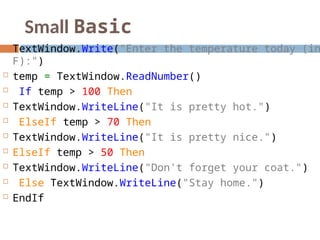
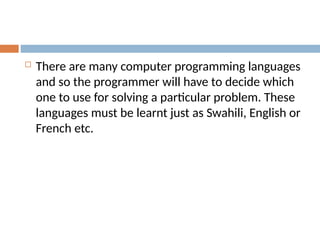











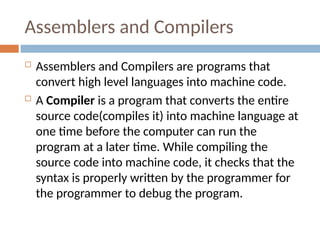






















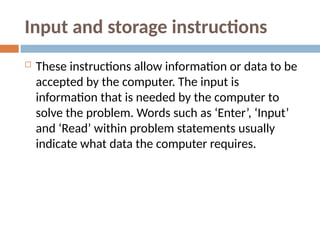




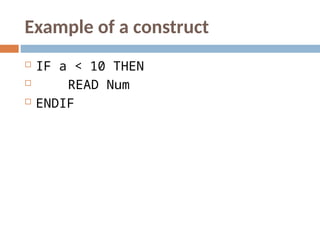



































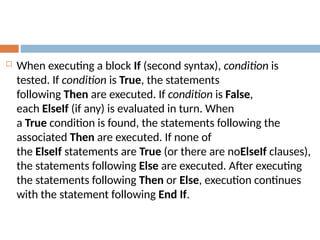

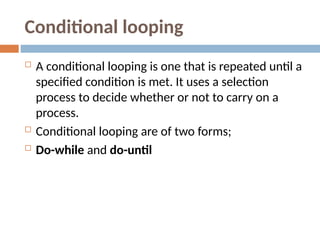







![ person["Name "] = " Kizito Samuel"
person["Age "] = 30
person["Address "] = " Wakiso"
TextWindow.WriteLine(person)](https://image.slidesharecdn.com/62136316-250209120628-a01d341b/85/Introduction-to-high-level-Computer-programming-93-320.jpg)

